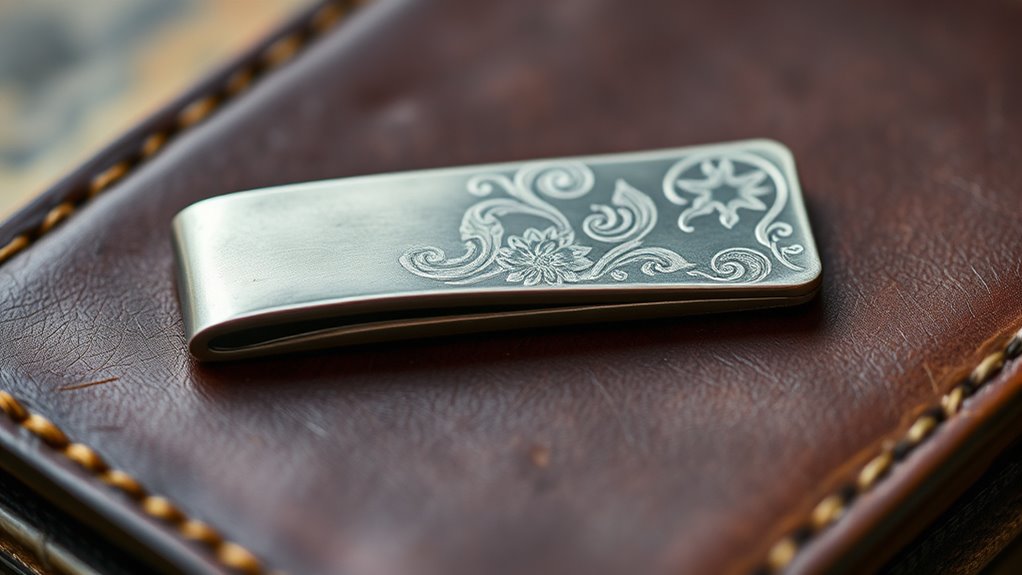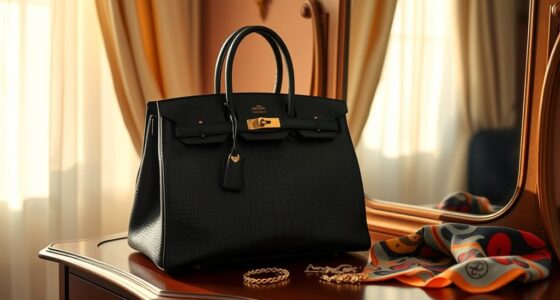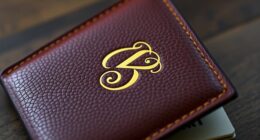The history of the money clip shows a long tradition of minimalism rooted in practicality, craftsmanship, and cultural symbolism that predates modern trends. Originally, simple containers and leather pouches held coins, evolving into sleek, personalized metal accessories. Wealth and status influenced designs, with intricate metalwork and unique symbols from different cultures. As styles shifted through the 19th and 20th centuries, money clips became symbols of sophistication and elegance. If you want to uncover more about their timeless appeal, keep exploring.
Key Takeaways
- Money clips originated in the 19th century as a minimalist alternative to bulky wallets for carrying cash.
- Early designs focused on durability and simplicity, often crafted from silver or gold with intricate craftsmanship.
- They symbolized wealth and status, with personalized engravings and cultural motifs enhancing their prestige.
- The shift toward sleek, modern materials like stainless steel and minimalist styles began in the 20th century.
- Today, money clips are celebrated as a timeless minimalist accessory, blending function with style before minimalism became mainstream.
Early Origins of Personal Money Storage
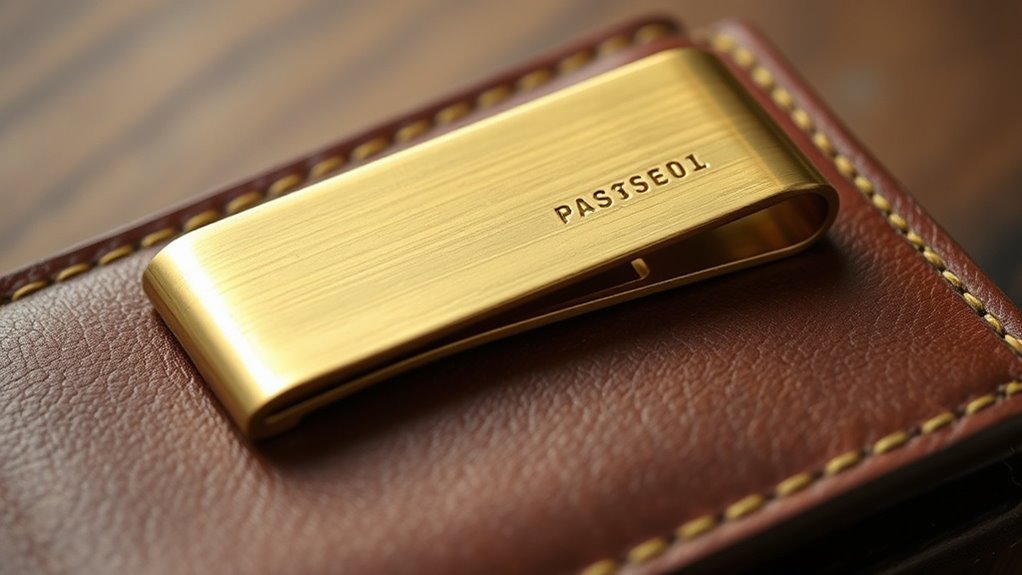
The earliest forms of personal money storage date back to ancient civilizations, where people needed practical ways to carry and secure their coins. As commerce evolved, early methods included leather pouches and simple containers. Today, the concept of storing money has expanded from physical items to digital solutions like cryptocurrency wallets, which securely hold digital currency. With the rise of digital banking, your money is often stored electronically, reducing the need for physical storage altogether. These modern tools streamline money management, making it easier to access and transfer funds instantly. While the materials and technology have changed dramatically, the core idea remains: securely carrying and safeguarding your money, whether in a physical or digital form. This evolution highlights a continuous quest for simplicity and security in personal finance.
Cultural Variations in Money Clip Designs

Different cultures often incorporate unique symbols and motifs into their money clip designs, reflecting local beliefs and traditions. You’ll notice regional material preferences, like gold in some areas or leather elsewhere, highlighting cultural values. Exploring these variations reveals how money clips serve not just practical purposes but also cultural expressions. Additionally, some designs subtly incorporate emotional connection elements that resonate with cultural identity, emphasizing the importance of cultural symbolism in personal accessories. The variations in craftsmanship and design also demonstrate how cultural values influence aesthetic choices in these personal items.
Cultural Symbolism and Motifs
Cultural symbolism deeply influences money clip designs, reflecting the values, beliefs, and aesthetic preferences of various societies. You’ll notice banking symbolism like lions or eagles, representing strength and authority, often embedded in designs. Cultural motifs also play a significant role, with motifs inspired by local art, mythology, or religious symbols. For example, some cultures incorporate intricate patterns or sacred symbols to convey protection or prosperity. These motifs not only serve functional purposes but also communicate cultural identity and status. By understanding these symbols, you can see how money clips become more than just practical accessories—they become expressions of cultural heritage and personal meaning. Each design tells a story rooted in the society’s history, values, and artistic traditions.
Regional Material Preferences
Have you ever noticed how regional preferences shape the materials used in money clips? Different areas emphasize unique regional craftsmanship and cultural symbolism through their choices. In Europe, you might see intricate silver or gold designs reflecting a history of fine metalwork. In Asia, materials like jade or lacquered wood symbolize cultural values and status. Meanwhile, North American styles often favor sturdy stainless steel or leather, highlighting practicality. These material choices tell stories about local traditions and values, making each money clip a small piece of regional identity. The craftsmanship and symbolism behind the materials reveal much about the cultural importance placed on personal finance accessories, blending function with regional pride.
The Evolution of Metalwork and Craftsmanship
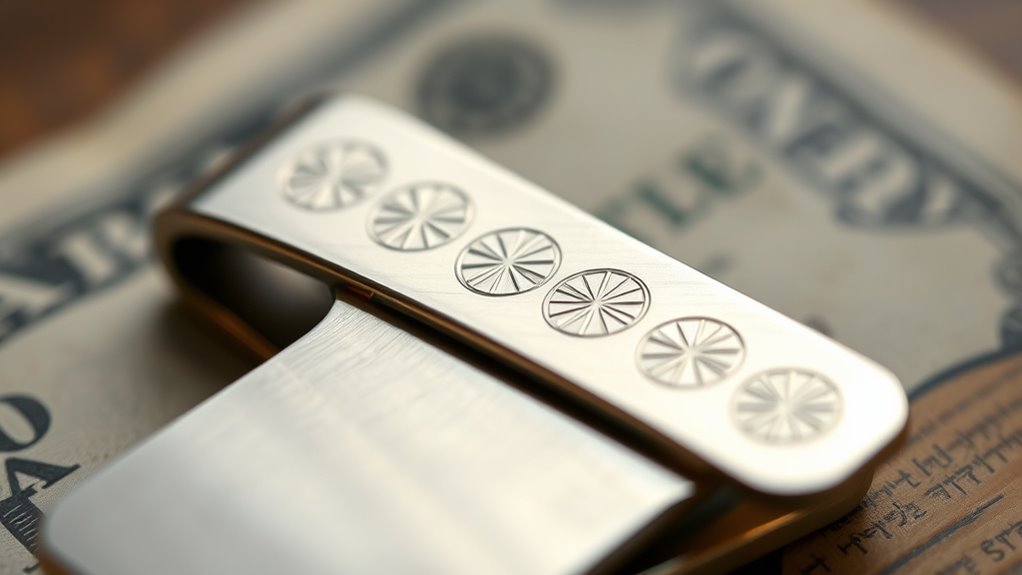
As metalworking techniques advanced over centuries, artisans developed increasingly sophisticated methods to shape and decorate metal objects, shaping the evolution of craftsmanship. You’ll notice how engraving techniques became more intricate, allowing artisans to add detailed patterns and personal touches to metal surfaces. These techniques elevated the artistry of small items like money clips, transforming them from simple tools into works of art. Additionally, artisans experimented with various metal alloy choices, balancing durability, appearance, and workability. The shift from basic metals to more refined alloys meant money clips could be made thinner, stronger, and more aesthetically appealing. This progress in metalwork not only improved functionality but also reflected evolving tastes and skills, setting the stage for the minimalist designs that would later define modern money clips.
The Role of Wealth and Status in Money Clip Development

Advancements in metalworking made it possible to craft more refined and decorative money clips, but their significance extended beyond mere utility. They became symbols of wealth symbolism and social hierarchy, reflecting status through design, materials, and craftsmanship. Wealthier individuals often chose luxurious metals like gold or silver, embedding intricate engravings or gemstones to showcase their prosperity. These details communicated power and privilege, reinforcing social distinctions. Visual cues of affluence, such as elaborate patterns or embossed emblems, helped owners project their status. As a result, money clips transcended their functional role, serving as subtle indicators of wealth and social standing. The use of precious metals and detailed craftsmanship further elevated their status-symbol function, making them desirable symbols of wealth. Additionally, the embellishments and motifs incorporated into their design often conveyed cultural or familial significance, further emphasizing their role as markers of prestige. The symbolic value of money clips grew as they became more personalized and reflective of individual identity within social hierarchies, with luxury branding also playing a role in their desirability. Moreover, designers began to experiment with innovative techniques, pushing the boundaries of traditional craftsmanship to create unique and highly collectible pieces.
The 19th Century: A Turning Point for Accessibility and Style

During the 19th century, money clips became more convenient for carrying cash and cards, fitting easily into pockets. Style also took center stage, blending fashion with practical design. Meanwhile, wealth was displayed subtly, allowing owners to show status without attracting too much attention. Additionally, the evolution of accessories like money clips reflected broader trends in minimalism and functional fashion. As technology progressed, the design of these accessories began to incorporate ergonomic considerations, making them more comfortable and easier to use. This period marked a significant shift toward compactness, emphasizing both utility and style for everyday wear. Furthermore, the integration of materials like silver and gold enhanced their durability and aesthetic appeal.
Rise of Pocket Convenience
The 19th century marked a pivotal shift in how people carried and accessed their money, making financial convenience more portable and stylish. As pockets grew larger and clothing more tailored, carrying cash and cards became easier and more discreet. You might imagine slipping notes into a sleek pocket or a compact clip holding your coins securely. With this evolution, the idea of digital wallets and cryptocurrency integration emerged as future innovations, even if they weren’t yet realized. The focus was on streamlining your everyday carry, combining function and fashion. The development of multi-functional furniture and organization tools also contributed to the broader movement toward minimalism and efficient space use. This period also saw the rise of modern wallet designs, which emphasized sleekness and ease of access, aligning with the minimalist ethos. Additionally, the integration of body awareness and physical sensations in design considerations reflects the ongoing influence of ergonomic and user-centered approaches. The shift toward ergonomic design further enhanced user comfort and accessibility, influencing modern accessories. Interestingly, the popularization of such accessories coincided with the rise of mass production, making these items more affordable and widely available. Today, the legacy of this shift influences how we view money storage—simple, accessible, and integrated into daily life. The 19th century truly set the stage for modern convenience in financial accessories.
Fashion Meets Functionality
As pockets grew larger and clothing became more tailored in the 19th century, you began seeking ways to carry money that balanced practicality with style. This era marked a shift toward integrating fashion with function, emphasizing sustainable fashion and gender neutral accessories. The popularity of sleek, versatile designs reflected a move away from ostentatious displays of wealth. Additionally, the focus on versatile accessories allowed for more personalized and adaptable options suited to individual tastes. These innovations made accessories more accessible and adaptable, allowing you to express individual style without sacrificing practicality. The emphasis on minimalism and versatility laid the groundwork for modern money clips, blending fashion with function seamlessly. The adoption of minimalist designs further contributed to the evolution of accessories that prioritize simplicity and utility over ornate decoration. Furthermore, the cultural shift towards sustainable fashion promoted the use of durable and timeless materials, influencing design choices that favored longevity and eco-friendliness. The period also saw a rise in gender-neutral accessories, which challenged traditional notions of fashion and expanded options for all individuals.
Wealth Display Subtlety
In the 19th century, a shift toward understated wealth emerged as fashion prioritized subtlety over ostentation. People began favoring discreet displays of luxury branding, where material symbolism conveyed status without shouting it. Instead of flashy adornments, refined accessories like slim money clips became symbols of sophistication. You might imagine:
- Fine, polished metals subtly engraved with minimal designs
- Slim, unobtrusive clips slipping smoothly into tailored pockets
- Quiet, elegant finishes reflecting wealth through craftsmanship rather than conspicuous logos
- The rise of minimalist design in accessories exemplified a broader cultural move toward understated elegance and functional sophistication during this period. This era also saw a rise in discreet luxury items that subtly signaled affluence without overt display, aligning with the increasing popularity of minimalism in fashion and personal accessories.
The Rise of the Pocket Watch and Its Impact on Accessories
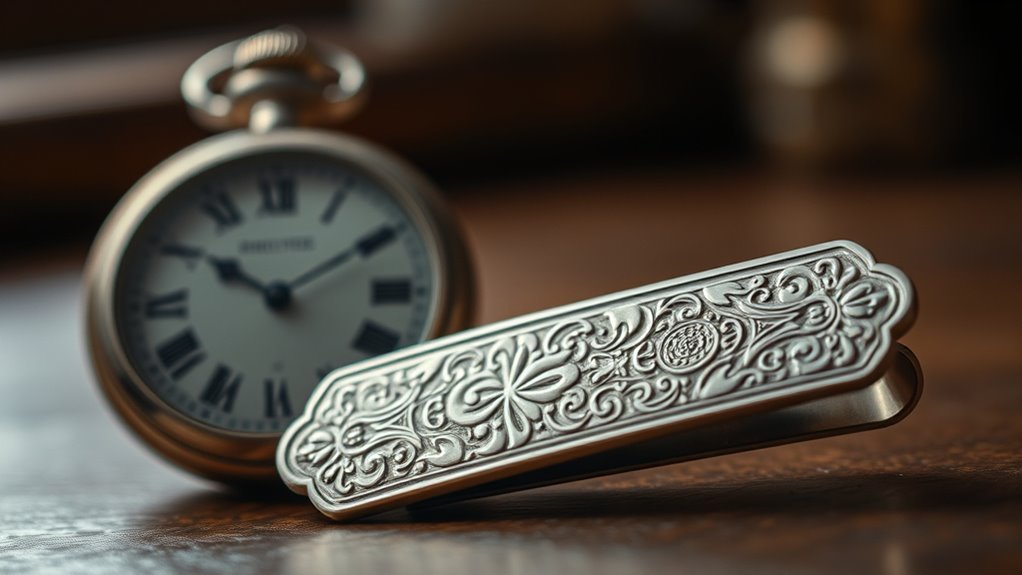
With the rise of the pocket watch in the 19th century, accessories began to shift from simple adornments to essential tools for daily life. The pocket watch became a symbol of punctuality and professionalism, transforming how men carried their accessories. Its design influenced other accessories, emphasizing practicality and style. The accessory impact of the pocket watch extended beyond timekeeping; it encouraged the development of watch fobs, chains, and protective cases, making them both functional and fashionable. You started to see accessories serving a dual purpose—enhancing your appearance while aiding daily routines. This shift marked a move away from purely decorative items, laying the groundwork for accessories that balanced utility with elegance, shaping men’s fashion for decades to come.
The 20th Century: From Practicality to Fashion Statement
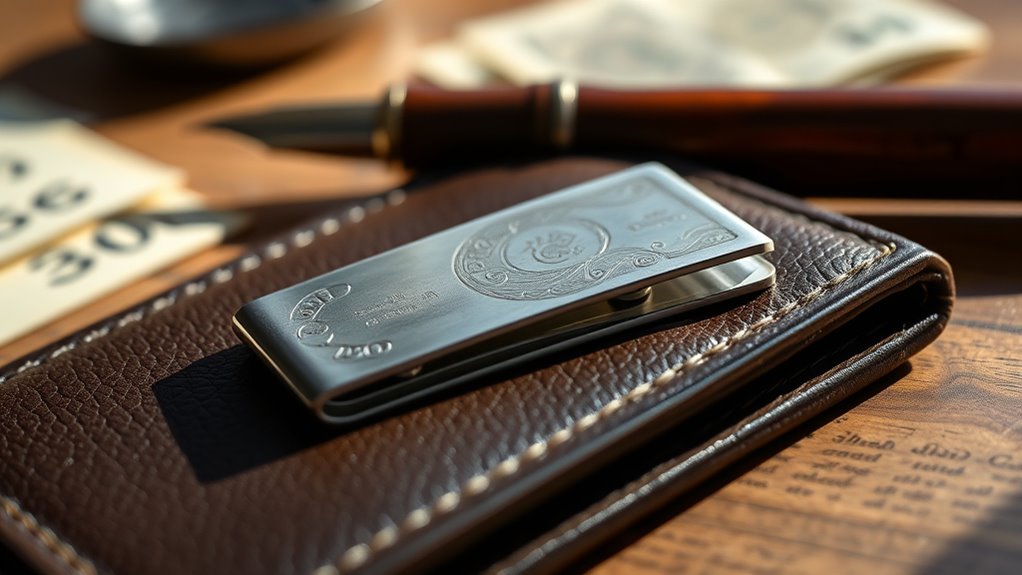
In the 20th century, money clips shifted from purely practical tools to fashion accessories. Designer labels and trends started influencing their style, making them statements of personal taste. You’ll see how practicality gave way to a focus on appearance and brand appeal during this period.
Shift From Utility to Style
As the 20th century unfolded, money clips shifted from simple tools designed solely for practicality to fashionable accessories that reflected personal style. No longer just functional, they became symbols of casual elegance and everyday sophistication. You might notice how designs evolved to feature sleek metals, intricate engravings, or even subtle embellishments. Visualize a polished silver clip with ornate patterns, exuding understated luxury. Or imagine a minimalist gold clip that adds a touch of refinement to your daily essentials. Some styles incorporated modern materials like stainless steel or leather accents, blending utility with fashion. This transformation allowed the money clip to serve as both a practical item and a statement piece, elevating everyday accessories into symbols of personal taste and style.
Designer Labels and Trends
Throughout the 20th century, designer labels and emerging trends transformed money clips into recognizable fashion statements. Luxury branding began to influence even small accessories, making money clips symbols of status and sophistication. Trendsetting styles emerged, with high-end brands creating unique designs that combined practicality with luxury appeal. You started noticing money clips featuring premium materials, intricate engravings, and prominent logos, signaling exclusivity. This shift elevated the money clip from a simple utility to a fashion accessory that reflected personal identity and social standing. As designer labels embraced these trends, owning a branded money clip became a way to showcase taste and wealth discreetly. Today, these trendsetting styles continue to influence how minimalism and luxury intersect in accessory design.
Iconic Figures and Their Influence on Money Clip Popularity
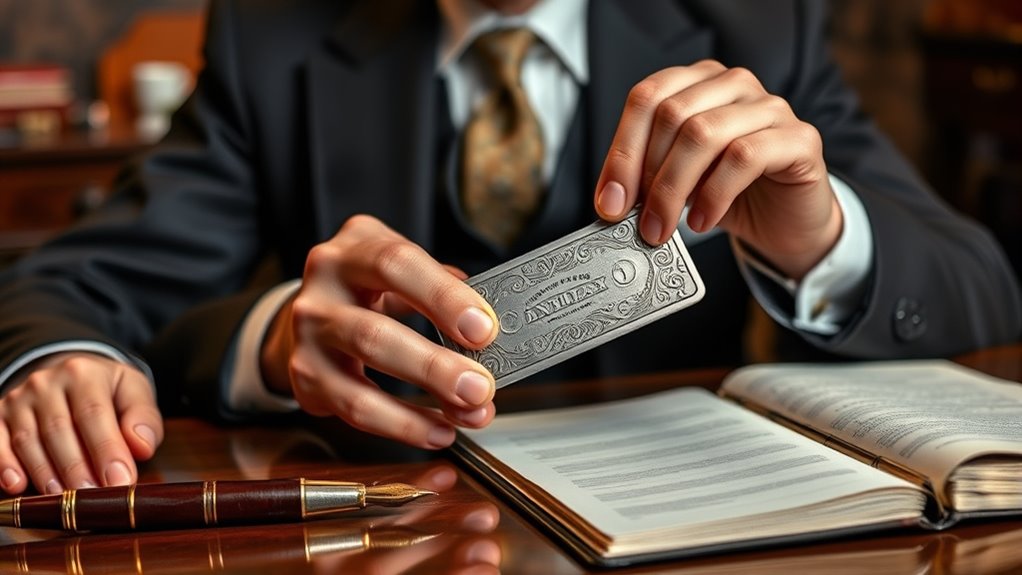
Iconic figures have considerably shaped the popularity of money clips by lending them a sense of prestige and style. Celebrity endorsements and pop culture influence have made money clips symbols of sophistication. When famous personalities showcase sleek, minimal designs, you start to see the appeal as a status symbol.
Iconic figures elevate money clips to symbols of prestige and sophistication.
- A well-dressed actor flashing a metallic clip on the red carpet
- A legendary musician sporting a vintage gold money clip in a music video
- A renowned businessman confidently holding his slim, stylish clip during interviews
These moments elevate money clips from simple accessories to symbols of success. Their association with influential figures encourages admiration and desire, making the money clip a classic, enduring item in men’s fashion.
Modern Innovations and Materials in Money Clip Design
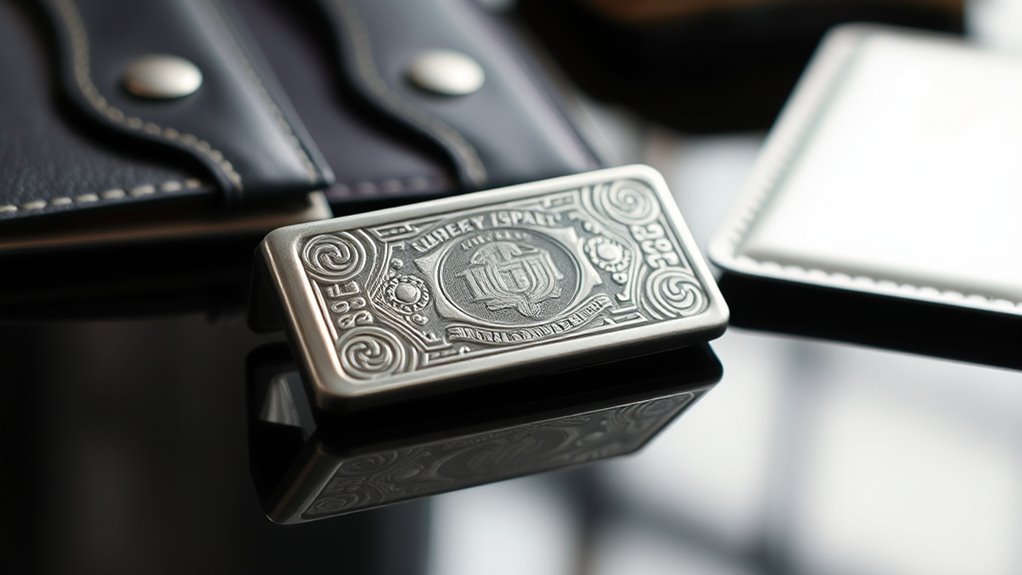
Modern money clips have embraced innovative materials and designs that enhance both functionality and style. Today’s clips often feature sleek metals like titanium, carbon fiber, and lightweight alloys, offering durability and a modern aesthetic. Some incorporate integrated RFID-blocking technology, protecting your digital information. As digital wallets grow in popularity, money clips now serve as versatile accessories, blending traditional minimalism with tech-savvy features. Cryptocurrency integration is also emerging, with designs that hold digital keys or connect to secure apps, bridging the gap between physical and digital assets. These innovations keep money clips relevant in a digital age, appealing to those who value simplicity without sacrificing security or modern style. The evolution continues, making money clips a practical and fashionable choice for today’s minimalist.
The Enduring Appeal of Minimalist Money Holders
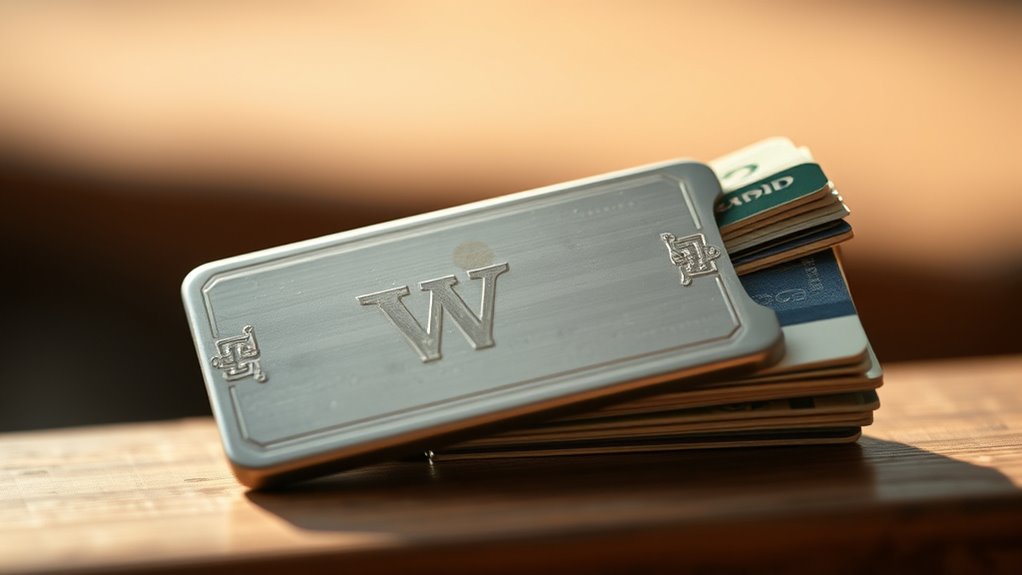
Despite the rise of digital payment methods, the enduring appeal of minimalist money holders remains strong because they offer simplicity, convenience, and elegance in everyday life. You value the sleek design that fits comfortably in your pocket and keeps your essentials organized. Minimalist wallets, like money clips, are timeless, complementing both formal and casual styles. They also serve as a statement of sophistication, reducing clutter and distraction. With the growth of cryptocurrency wallets and digital payment systems, these holders adapt to modern needs without losing their charm. You can carry a few bills and cards effortlessly, knowing they stay secure and accessible. Whether you prefer leather, metal, or innovative materials, minimalist money holders continue to symbolize a lifestyle that appreciates function and form.
Frequently Asked Questions
How Did Money Clips Influence Modern Minimalist Wallets?
Money clips profoundly influenced modern minimalist wallets by shaping their design evolution to prioritize simplicity and efficiency. You’ll notice that user preferences now favor slim, sleek options that hold essentials without bulk. This shift reflects the timeless appeal of the money clip’s minimalist approach, inspiring wallet designers to create products that meet modern needs while maintaining a clean, streamlined look. The legacy of the money clip continues to influence minimalist wallet trends today.
Are There Cultural Symbols Embedded in Traditional Money Clip Designs?
You might not realize it, but traditional money clip designs often carry hidden cultural symbolism and design motifs. These elements can tell stories, reflect heritage, or showcase societal values. As you examine a classic money clip, look closely—you’ll uncover symbols that connect to specific cultures or beliefs, adding a layer of meaning beyond mere functionality. What secrets do these tiny, crafted pieces hold about the traditions they represent?
What Materials Were Historically Used for Ornate or Ceremonial Money Clips?
You’ll find that historically, ornate craftsmanship and ceremonial adornments made money clips stand out. Silver and gold were popular choices because they offered durability and a luxurious look, often engraved with detailed patterns or symbols. Sometimes, precious stones or intricate metalwork added a special touch. These materials reflected the importance of the occasion or the status of the owner, making them more than just functional items—they became symbols of prestige.
How Did Technological Advances in Metallurgy Affect Money Clip Durability?
With a touch of elegance, you see how metalwork innovations and alloy development have considerably boosted money clip durability. Your choice of materials benefits from advances in metallurgy, making clips more resilient and long-lasting. These technological strides allow for thinner, stronger, and more refined designs, ensuring your money clip withstands daily use while maintaining a sophisticated appearance. Therefore, progress in metallurgy directly elevates both function and style in modern money clips.
What Are the Environmental Impacts of Modern Money Clip Manufacturing?
You might not realize it, but modern money clip manufacturing faces recycling challenges due to mixed materials that complicate recycling processes. Additionally, material sustainability is a concern, as demand for metals and other resources increases. By choosing eco-friendly options and supporting brands committed to sustainable practices, you can help reduce environmental impacts and promote responsible manufacturing. Your choices can make a difference in creating a more sustainable future.
Conclusion
You’ve seen how the money clip’s history reflects a journey from simple practicality to a symbol of style. As the saying goes, “less is more,” and that’s exactly what makes these minimalist holders timeless. Whether crafted from precious metals or modern materials, they’re more than just functional—they’re a statement of elegance and personality. Keep it simple, keep it stylish, and remember, sometimes less truly is more.
